
Aitken is a large lunar impact crater that lies on the far side of the Moon, named for Robert Grant Aitken, an American astronomer specializing in binary stellar systems. It is located to the southeast of the crater Heaviside, and north of the unusual formation Van de Graaff. Attached to the southwest rim is Vertregt. To the southeast is the smaller Bergstrand.

Cavalerius is a prominent lunar impact crater that lies on the western edge of the Oceanus Procellarum lunar mare on the west part of the visible Moon. It nearly joins the northern rim of Hevelius to the south.

Doppelmayer is the remains of a lunar impact crater that lies on the southwest edge of Mare Humorum. It was named after the German mathematician and astronomer Johann Gabriel Doppelmayr. To the south-southeast is another flooded crater designated Lee, and to the southeast is Vitello. Just to the east-northeast of Doppelmayer lies the nearly submerged crater Puiseux.

Boyle is a lunar impact crater that is located in the southern hemisphere on the rugged far side of the Moon. It is adjacent to the larger crater Hess to the southeast, and lies about midway between the craters Alder to the north-northeast and Abbe to the south-southwest.

Gioia is a lunar impact crater that is located in the vicinity of the north pole of the Moon. It is named after the Italian inventor Flavio Gioia. As it lies so close to the northern limb, it is viewed nearly from the edge making difficult to observe from the Earth. The crater is attached to the southern rim of the larger Byrd, a formation with low walls. To the south-southeast is the crater Main.

Desargues is an ancient lunar impact crater that is located near the northern limb of the Moon, on the western hemisphere. It lies nearly due south of the crater Pascal, and southeast of Brianchon. The proximity of this crater to the limb means that it appears highly elongated due to foreshortening, and it is difficult to discern details from the Earth.

Rozhdestvenskiy is a large lunar impact crater that is located on the far side of the Moon, within one crater diameter of the north pole. It lies sandwiched between the craters Hermite along the eastern rim, and Plaskett which intrudes slightly into the west-southwestern rim. Just on the opposite side of the pole is the crater Peary.

Cuvier is a lunar impact crater on the southern part of the Moon's near side. It is attached to the east-southeast rim of the unusually shaped formation Heraclitus. To the northeast is the crater Clairaut.
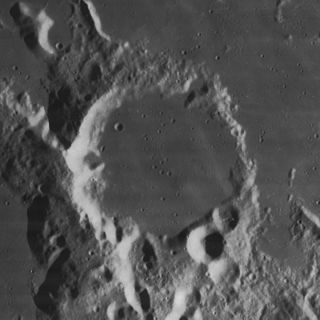
Capuanus is a lunar impact crater that lies along the southern edge of the Palus Epidemiarum. It was named after Italian astronomer F. Capuano di Manfredonia. The outer rim is eroded and indented by lesser crater impacts, with notches in the north, west, and southern parts of the rim. The interior floor has been resurfaced by basaltic lava, which is connected to the surrounding lunar mare by a narrow, crater-formed gap in the northern rim. Dotting the floor of the crater are a number of domes, which are believed to have formed through volcanic activity.

Casatus is a lunar impact crater that is located near the southern limb of the Moon. The north-northeast rim of the crater overlies a portion of the slightly larger crater Klaproth. Along the western rim, Casatus A intrudes somewhat into the interior, producing an inward-bowing rim. To the southeast of Casatus is Newton.
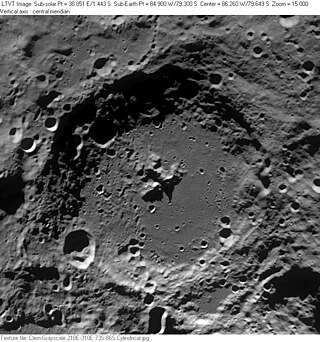
Drygalski is a large lunar impact crater that lies along the southern limb of the Moon. It partly overlies the crater Ashbrook to the west on the far side of the Moon. Just to the north of Drygalski is the smaller Boltzmann. The location of this crater restricts its observation from the Earth, and even under conditions of favorable libration it is viewed from the edge. It is only illuminated by the Sun at an oblique angle, and it lies close to the south polar craters that are permanently shielded from sunlight.
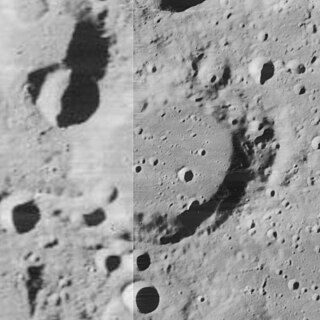
Cleostratus is a lunar impact crater near the northwest limb of the Moon. It lies to the northeast of the crater Xenophanes, and west-southwest of the prominent Pythagoras. From the Earth this crater appears highly elongated due to foreshortening.

Pascal is a lunar impact crater that lies near the northern limb of the Moon, on the western side of the pole. It is located to the north of the eroded crater Desargues, and just east of Brianchon. Pascal can be located by finding the crater Carpenter and then following the surface to the northwest towards the limb. However the visibility of this formation can be affected by libration.

Sumner is a lunar impact crater on the far side of the Moon, beyond the northeastern limb. It is southwest of the larger crater Szilard, and southeast of the twin walled plains Fabry and Harkhebi.

Cannizzaro is a lunar impact crater that is located on the Moon's far side as seen from the Earth, just beyond the northwestern limb. It lies in a region of the surface that is sometimes brought into view due to the effects of libration, but not much detail can be seen since this feature is viewed from the side. The crater lies across the southwestern rim of the much larger-walled plain Poczobutt.

Chappell is a lunar impact crater on the far side of the Moon, in the northern hemisphere just to the north of the crater Debye. It is in a heavily bombarded section of the surface, and much of its outer rim is overlain by smaller craters. The northern rim in particular has been almost completely disintegrated, while small craters also overlie the rim to the northwest and southeast. What remains of the rim forms a rounded, somewhat irregular edge to the crater depression.

Dyson is a lunar impact crater, 63 kilometers in diameter, that lies on the far side of the Moon, past the northwest limb. It is located in the northern part of the surface, to the northwest of the crater Coulomb, and east of van't Hoff.
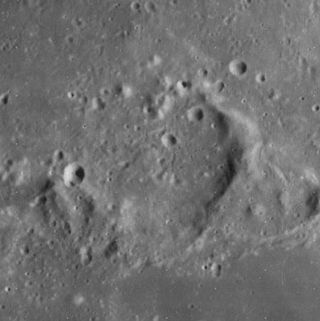
Williams is the remnant of a lunar impact crater that lies to the south of the prominent crater Hercules, in the northeastern part of the Moon. The southern rim borders the Lacus Somniorum, a small lunar mare that extends to the south and west. To the southwest is the sharp-rimmed crater Grove.

Evershed is a lunar impact crater on the far side of the Moon, named after the English solar astronomer John Evershed. It is located to the northeast of the larger crater Cockcroft, and to the north of the smaller Van den Bergh.
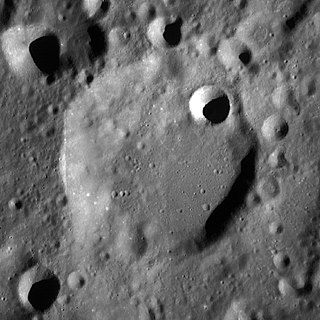
Evdokimov is a lunar impact crater on the far side of the Moon. It lies to the east of the crater Evershed, and west-southwest of Gadomski. This is a worn and eroded feature with a somewhat indistinct outer rim that is little more than a slight ridge in the surface. The rim is better formed along the western and eastern sides. A small crater with a relatively high albedo lies along the inner wall to the northeast, and is surrounded by a small, bright skirt of ejecta. The interior floor is nearly featureless, with only a few indistinct small crater rims marking the surface.






















